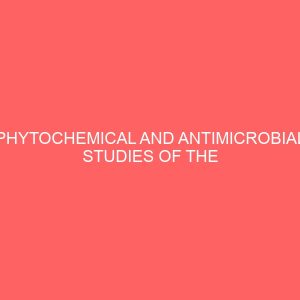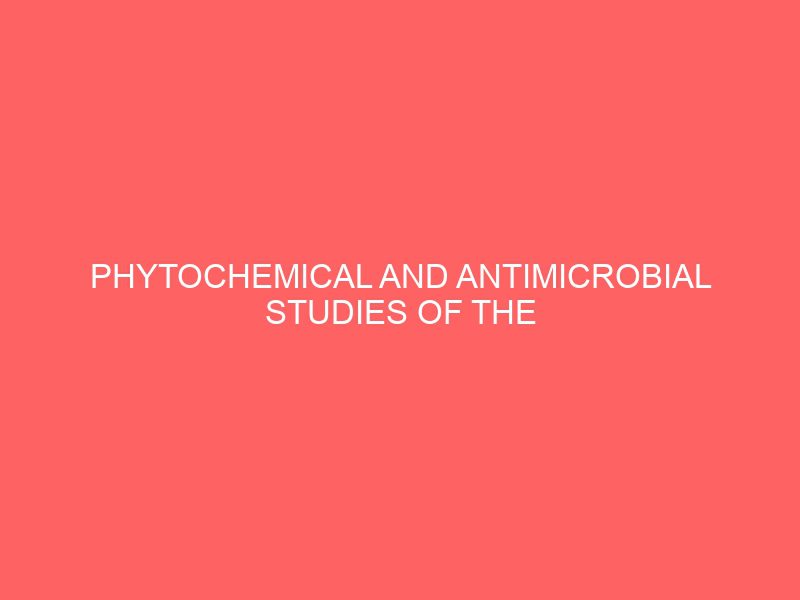Description
CHAPTER ONE
1.0 INTRODUCTION
This project is on Phytochemical and antimicrobial studies of the methanol extract of the root of Napoleonaea Heudelotti (A.Juss). Medicinal plants have been identified and used throughout human history. Plants have the ability to synthesize a wide variety of chemical compounds that are used to perform important biological functions, and to defend against attack from predators such as insects, fungi and herbivorous mammals (Babalola, 2009). Chemical compounds in plant mediate their effects on the human body through processes identical to those already well understood for the chemical compounds in conventional drugs; thus herbal medicines do not differ greatly from conventional drugs in terms of how they work. This enables herbal medicines to be as effective as conventional medicines, but also gives them the same potential to cause harmful side effects. Ethnobotany (the study of traditional human uses of plants) is recognized as an effective way to discover future medicines. In 2001, researchers identified 122 compounds used in modern medicine which were derived from ethnomedical plant sources (Babalola, 2009). Many of the pharmaceuticals currently available to physicians have a long history of use, as herbal remedies, including aspirin, digitalis, quinine, and opium. Treatment of diseases is almost universal among non-industrialized societies, and is often more affordable than purchasing expensive modern pharmaceuticals (Beltrame et al., 2002). The World Health Organization (WHO) estimates that 80 percent of the population of some Asian and African countries presently use herbal medicine for some aspect of primary health care (Beltrame et al., 2002). Studies in the United States and Europe have shown that the use of herbal madicine is less common in clinical settings, but has become increasingly more in recent years as scientific evidence about it effectiveness has become more widely available. The annual global export value of pharmaceutical plants in 2011 accounted for over US$ 2.2 billion. Plants have continued to be major source of medicine either in the form of traditional medicine preparations or as pure active principles (Hill, 2011). This has made it important to identify plants with useful therapeutic actions for possible isolation and characterization of their active constituents. About 80 % of the world population relies on the use of traditional medicine which is predominantly based on plant materials (Brunton et al., 2006). Plant have been part of our lives since beginning of time, we get numerous products from plants, most of them, not only good and beneficial but also crucial to our existence. The use of plant to heal or combats illness is probably as old as human kind. Out of these simple beginning came the pharmaceutical industry. Yet the current view of plant is very different from how it all started. The acceptance of traditional medicine as an alternate form of health care and the development of microbial resistance to the available antibiotics has led researchers to investigate the antimicrobial herbal extract (WHO, 1993). In Africa, particularly Nigeria is rich in plants which are used in herbal medicine to cure diseases and to heal injuries. Some of these plants exhibit a wide range of biological and pharmacological activities such as antihelmenthics, oxytoxic laxative (Hostettmann et al., 2012). The secondary metabolites of plant provide human with numerous biological active components which have been used extensively as drugs, foods, additives, flavours, insecticides and chemicals. They exhibited remarkable biological activities, which include inhibitory effects on enzymes, modulatory effects on some cell types, protect against allergies antioxidants (Dongmo et al., 2001).
1.2 SECONDARY METABOLITES
1.2.1 Alkaloid
Alkaloids are a group of naturally occurring chemical compounds that contain mostly basic nitrogen atoms e.g Coniine (1) and Quinine (2). This group also includes some related compounds with neutral and even weakly acidic properties. Some synthetic compounds of similar structure are also attributed to alkaloids. In addition to carbon, hydrogen and nitrogen, alkaloids may also contain oxygen, sulphur and more rarely other elements such as chlorine, bromine, and phosphorus. Alkaloids are produced by a large variety of organisms, including bacteria, fungi, plants, and animals, and are part of the group of natural products (also called secondary metabolites). Many alkaloids can be purified from crude extracts by acid-base extraction. Many alkaloids are toxic to other organisms (Kumar et al., 2010). They often have pharmacological effects and are used as medications, as recreational drugs, or in entheogenic rituals (Kumar et al., 2010).
1.2.2 Flavonoid
Flavonoids are a class of plant secondary metabolites. Flavonoids are also described as non-ketone polyhydroxy polyphenol compounds which are more specifically termed as flavanoids e.g Isoflavan (3) and Neoflavonoid (4). The three cycle or heterocycles in the flavonoid backbone are generally called ring A, B and C. Ring A usually shows a phloroglucinol substitution pattern. Flavonoids are widely distributed in plants, fulfilling many functions (Dongmo et al., 2001). Flavonoids are the most important plant pigments for flower coloration, producing yellow or red/blue pigmentation in petals designed to attract pollinator animals. In higher plants, flavonoids are involved in UV filtration, symbiotic nitrogen fixation and floral pigmentation. They may also act as chemical messengers, physiological regulators, and cell cycle inhibitors (Kumar et al., 2010).
1.2.3 Terpene
Compounds classified as terpenes constitute what is arguably the largest and most diverse class of natural products. A majority of these compounds are found only in plants, but some of the larger and more complex terpenes occur in animals, e.g Isopentenyl pyrophosphate (5), is the basic unit in which terpene exist in natural organism. Instead, the number and structural organization of carbons is a definitive characteristic. Terpenes may be considered to be made up of isoprene (more accurately isopentane) units, an empirical feature known as the isoprene rule (Dongmo et al., 2001).
1.2.4 Steroid
The important classes of lipids called steroids are actually metabolic derivatives of terpenes, but they are customarily treated as a separate group. Steroids may be recognized by their tetracyclic skeleton, consisting of three fused six-membered and one five-membered ring. These rings are synthesized by biochemical processes from cyclization of a thirty-carbon chain. Hundreds of steroids are found in animals, fungi and plants e.g cholesterol (6), the sex homones, estradiol and testosterone (Kaisar et al., 2011).
1.2.5 Saponins
Saponins are a class of chemical compounds found in abundance in various plant species. More specifically, they are amphipathic glycosides grouped by the soap-like foaming they produce when shaken in aqueous solutions, and structurally by having one or more hydrophilic glycoside moieties combined with a lipophilic triterpene derivative (Kaisar et al., 2011).
Saponins have historically been understood to be plant-derived, but they have also been isolated from marine organisms. Saponins are indeed found in many plants, and derive their name from the soapwort plant (genus Saponaria, family Caryophyllaceae), the root of which was used historically as a soap. Saponins are also found in the botanical family
Sapindaceae, with its defining genus Sapindus (soapberry or soapnut), and in the closely related families Aceraceae (maples) and Hippocastanaceae. An example of saponin is solanine (7). It is also found heavily in Gynostemma pentaphyllum (Gynostemma, Cucurbitaceae) in a form called gypenosides, and ginseng or red ginseng (Panax, Araliaceae) in a form called ginsenosides. Within these families, this class of chemical compounds is found in various parts of the plant: leaves, stems, roots, bulbs, blossom and fruit. Commercial formulations of plant-derived saponins, e.g., from the soap bark (or soapbark) tree, Quillaja saponaria, and those from other sources are available via controlled manufacturing processes, which make them of use as chemical and biomedical reagents. Saponins are used widely for their effects on ammonia emissions in animal feeding. The mode of action seems to be an inhibition of the urease enzyme, which splits up excreted urea in feces into ammonia and carbon dioxide (Kaisar et al., 2011).
1.2.6 Tannins
A tannin is an astringent, bitter plant polyphenolic compound that binds to and precipitates proteins and various other organic compounds including amino acids and alkaloids.
The term tannin (from tanna, an Old High German word for oak or fir tree, as in Tannenbaum) refers to the use of wood tannins from oak in tanning animal hides into leather; hence the words “tan” and “tanning” for the treatment of leather. However, the term “tannin” by extension is widely applied to any large polyphenolic compound containing sufficient hydroxyls and other suitable groups (such as carboxyls) to form strong complexes with various macro molecules (Kaisar et al., 2011).
The tannin compounds (e.g Gallic acid (8)) are widely distributed in many species of plants, where they play a role in protection from predation, and perhaps also as pesticides, and in plant growth regulation. The astringency from the tannins is what causes the dry and puckery feeling in the mouth following the consumption of unripened fruit or red wine. Likewise, the destruction or modification of tannins with time plays an important role in the ripening of fruit and the aging of wine (Kaisar et al., 2011). .







